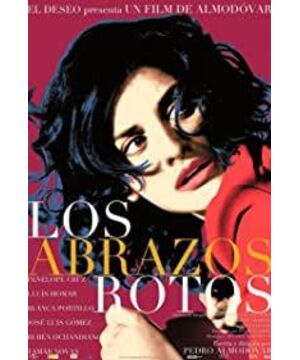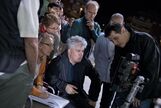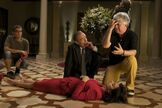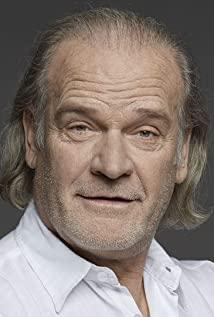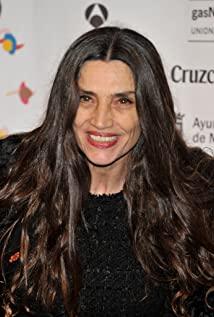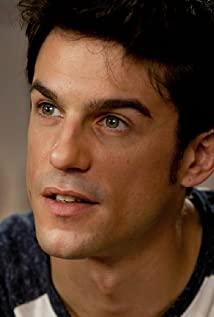The film "Broken Embrace", as another representative of Uncle Amo's personal stylized film, is only labelled as "same excellent" or "not as good as before", which is somewhat despised.
He uses the partial "red" of the object to imply life, the "eye" to clamp the soul, and the "language" to symbolize the key to Pandora's box. The technique of holding objects and expressing will is still used. This knife is actually very useful. Sharp. But when you watch this film, in the process of leading to the core of life, you feel the same Almodóvar-style Spanish style, colorful, and rich and bizarre story. There is no rendering of the film in an attempt to "deviate" and look for the heaviness of a new life, which cannot but be said to be a kind of skill. And the depth of his performance of the director's return to the "blind screenwriter" as a specific character in the film should be a major review of his own cognitive system and a reserved self-assessment.
Like this film, more emotion comes from the rigorous and complex narrative structure. It's not a play in a simple sense, a picture in a picture. Starting from the newspaper in the girl's eyeballs, the lens in the vignetting corner lives in my mind. It seems that everyone can be a clue to extend the story, and at the same time, everyone's vision can be seen as a screen. Flashbacks, interludes, and supplementary narratives, as long as they are helpful for narrative, can be used as the driving force of the story. The magnificent circular staircase in the building, the stone steps kissed by the natural sea breeze, sand and stone on the island, the stone staircase with different footprints on the street bridge, there are always upward or downward ladders into the picture, which can not be ignored. The scene of Mr. Ernest standing at the top of the stairs, pushing quickly from behind Lena, causing her to roll down the stairs, is too meaningful. The true portrayal of human nature is full of comic effects, but it creates a tragic atmosphere. The scene where Judith comes out of the island shop to call Matthew's new name "Harry" on the beach is a finishing touch in my opinion. The two echoed each other, simple and vivid, but they pushed all the complicated feelings to me who watched the movie. At that moment, I felt the meaning that Almodóvar gave Matthew a new life. Life is so wonderful! However, looking at the whole story again, you will find a truth. It is not your business to create life, but you will have to rely on yourself to follow the path of life.
To tell the whole story, it is necessary to go back to 1992 from 2008, starting with the death of Lena's father from cancer. Lena, who was a secretary at that time, had been in an ambiguous relationship with her boss, Mr. Ernest, because of a certain desire. Although Mr. Ernest's help in the end made the two establish a romantic relationship, this can only be regarded as a transaction. Lena proved all this when she met Matthew. To be sure, Lena did not succeed in getting rid of her old love, nor did she get peace and happiness. In this play, two female characters are still sacrificed. Lena compromised for desire, eloped for love, and finally sacrificed love with her life; while Judith, a single mother whose sexual orientation was misunderstood, turned out to be a poor woman manipulated by jealousy, and was not freed until the end.
As for the male protagonist Matthew, who turned from a healthy film director to a blind playwright "Harry", everything encountered during this period is the whole story of the film. Regarding his personality traits, it is better to use one word to modify it, and it is irresponsible. Diego is his illegitimate child, and the audience knows the truth, but it is still a secret to Harry, which is enough to see a man's sense of responsibility. After Lena's death, Harry adopted an evasive attitude towards life. This is undoubtedly revealed in the scripts and speeches he created. I think this is irresponsible to himself. And the story that the film actually wants to tell, thinking about it, is just an unsatisfactory, late love tragedy; a woman in a man's heart that can never be forgotten; a dead person, left in the memory of a group of living people Under life. But after Uncle Amo’s magical director, the story was stuffed into a kaleidoscope, dazzling. For several different kinds of love shots, I personally admire the subtle style, the feet on the back of the sofa chair, and you and me in the white sheets. The performance is not weak, no less than that of white flowers. Hand-to-hand combat, as far as a certain mood is concerned, sometimes the “obscene” that hides the picture can also express eroticism very well. In fact, what I really want to say is that using erotic toner for movies sometimes seems redundant. But this is the style of Almodovar, what can I say.
In any case, what Uncle Amo wants to tell everyone may be such a state that his energy and creativity will not be exhausted.
Like the pre-opening stage, Harry climbed the peak of love in the dark world, which is really an incomparably public way of showing off. There is no way to be critical. Uncle Amo’s films have always been like this. The vitality of life is vented naked, and the relationship between people is twisted together in twists and turns.
At the end, although there is an epiphany of sitting on the ground, there is no exaggerated feeling of becoming a Buddha. This is also detachment, and it is considered rebirth. Harry regained his identity, sat on the 2008 Space-Time Station, and re-edited the last film about Lena made in 1994 with a more relieved attitude for ordinary people. It might be a kind of creative power to abandon the inherent thinking. At the same time, it also conveyed another voice. The reason why our lives are perfect is that our lives are incomplete like broken pictures. Incompleteness is a kind of beauty, and perhaps a broken embrace is also a kind of eternity. There is a saying that goes well, "Comedy comes from painful memories."
View more about Broken Embraces reviews


